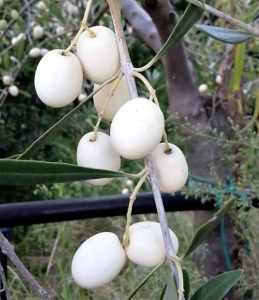The Enigmatic Elegance Of The White Olive: A Mediterranean Marvel
The olive tree, a symbol of peace, wisdom, and abundance, has long held a special place in the hearts of people across the Mediterranean region. While most are familiar with the traditional green and black olives, there exists a lesser-known, yet equally fascinating variety known as the “white olive.” In this article, we delve into the unique qualities and cultural significance of the white olive.

Origins and Cultivation
The white olive, scientifically known as “Olea europaea var. leucocarpa,” hails from the sun-kissed landscapes of the Mediterranean, where olive cultivation has thrived for millennia. This remarkable variant derives its name from the distinct ivory hue of its ripe fruit. Unlike its green and black counterparts, the white olive remains a rare find, even in the heartland of olive production.

Appearance and Flavor Profile
The distinguishing feature of the white olive is its stunning ivory or pale yellow color, which sets it apart from the more common green and black olives. This unique appearance is the result of a genetic mutation that affects the chlorophyll content in the fruit. Despite its lighter color, the white olive boasts a rich, savory flavor profile. Its taste is often described as slightly nutty, with a subtle sweetness that complements its mild brininess.

Cultural Significance
The white olive, though not as widely recognized as its counterparts, holds its own special place in Mediterranean culture and cuisine. It has been featured in traditional dishes, such as salads, tapenades, and various olive-based spreads, adding a touch of elegance and novelty to the culinary scene. Its creamy appearance and delicate flavor make it a sought-after ingredient among chefs and food enthusiasts.

Furthermore, the white olive carries symbolic significance in the region. Its unique coloration has been associated with purity, renewal, and hope. In some cultures, it is used during special ceremonies or festivals to mark significant life events, such as weddings and baptisms, as a symbol of prosperity and peace.
Health Benefits
Like its green and black counterparts, the white olive is a nutritional powerhouse. It is rich in monounsaturated fats, which are known to promote heart health. Additionally, it contains antioxidants, vitamins, and minerals that contribute to overall well-being. The consumption of white olives has been linked to improved digestion, reduced inflammation, and enhanced cognitive function.
The white olive, with its unique appearance, delicate flavor, and cultural significance, stands as a testament to the diversity and richness of Mediterranean cuisine and heritage. While it may not be as common as the green or black olive, its rarity only adds to its allure and desirability. Whether enjoyed as a delectable snack, a culinary ingredient, or a symbol of tradition, the white olive continues to captivate those fortunate enough to encounter its subtle beauty and taste.
The olive tree, a symbol of peace, wisdom, and abundance, has long held a special place in the hearts of people across the Mediterranean region. While most are familiar with the traditional green and black olives, there exists a lesser-known, yet equally fascinating variety known as the “white olive.” In this article, we delve into the unique qualities and cultural significance of the white olive.

Origins and Cultivation
The white olive, scientifically known as “Olea europaea var. leucocarpa,” hails from the sun-kissed landscapes of the Mediterranean, where olive cultivation has thrived for millennia. This remarkable variant derives its name from the distinct ivory hue of its ripe fruit. Unlike its green and black counterparts, the white olive remains a rare find, even in the heartland of olive production.

Appearance and Flavor Profile
The distinguishing feature of the white olive is its stunning ivory or pale yellow color, which sets it apart from the more common green and black olives. This unique appearance is the result of a genetic mutation that affects the chlorophyll content in the fruit. Despite its lighter color, the white olive boasts a rich, savory flavor profile. Its taste is often described as slightly nutty, with a subtle sweetness that complements its mild brininess.

Cultural Significance
The white olive, though not as widely recognized as its counterparts, holds its own special place in Mediterranean culture and cuisine. It has been featured in traditional dishes, such as salads, tapenades, and various olive-based spreads, adding a touch of elegance and novelty to the culinary scene. Its creamy appearance and delicate flavor make it a sought-after ingredient among chefs and food enthusiasts.

Furthermore, the white olive carries symbolic significance in the region. Its unique coloration has been associated with purity, renewal, and hope. In some cultures, it is used during special ceremonies or festivals to mark significant life events, such as weddings and baptisms, as a symbol of prosperity and peace.
Health Benefits
Like its green and black counterparts, the white olive is a nutritional powerhouse. It is rich in monounsaturated fats, which are known to promote heart health. Additionally, it contains antioxidants, vitamins, and minerals that contribute to overall well-being. The consumption of white olives has been linked to improved digestion, reduced inflammation, and enhanced cognitive function.
The white olive, with its unique appearance, delicate flavor, and cultural significance, stands as a testament to the diversity and richness of Mediterranean cuisine and heritage. While it may not be as common as the green or black olive, its rarity only adds to its allure and desirability. Whether enjoyed as a delectable snack, a culinary ingredient, or a symbol of tradition, the white olive continues to captivate those fortunate enough to encounter its subtle beauty and taste.



